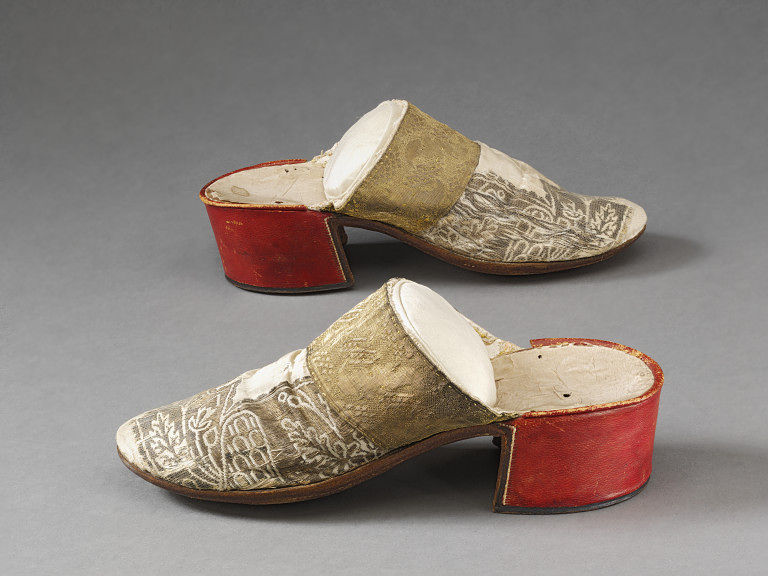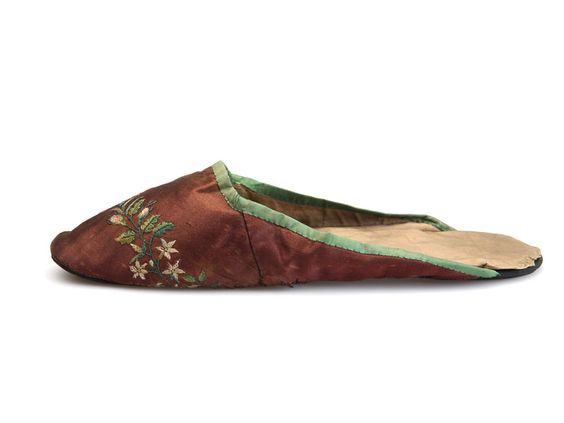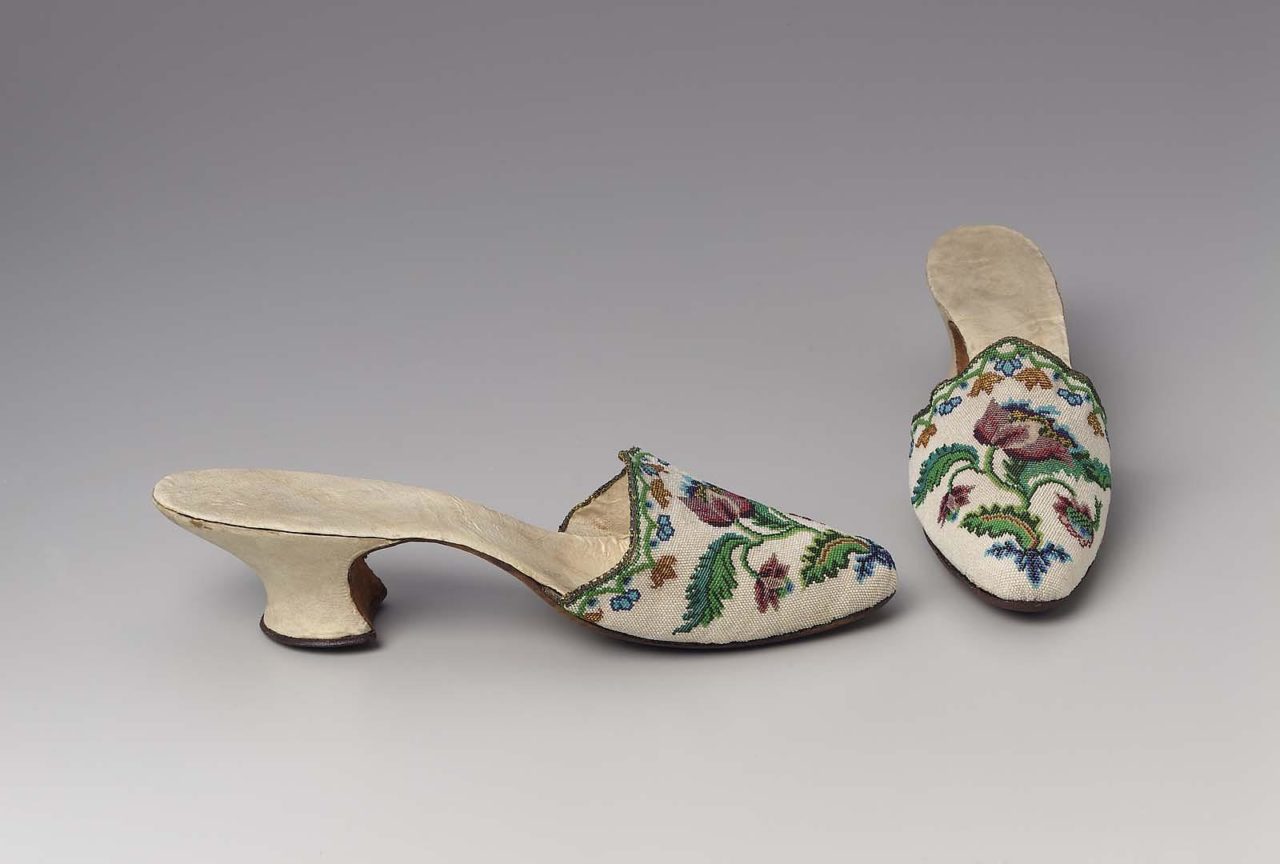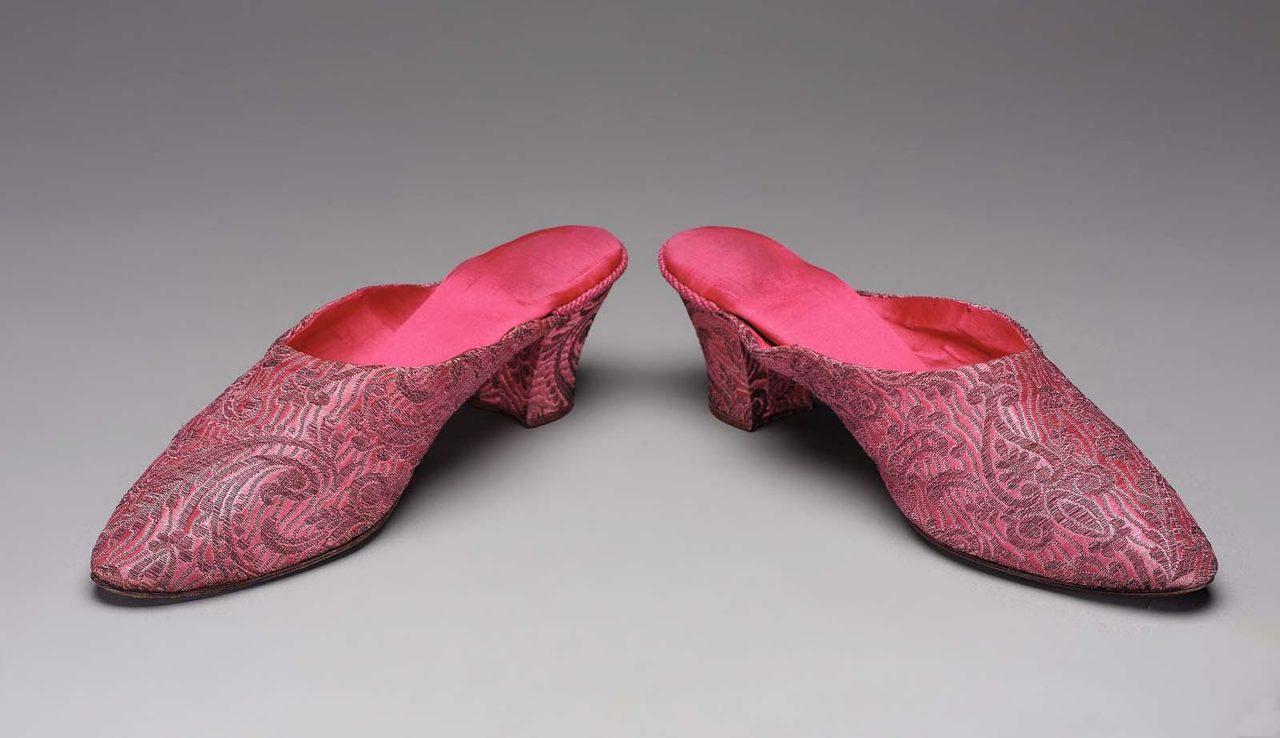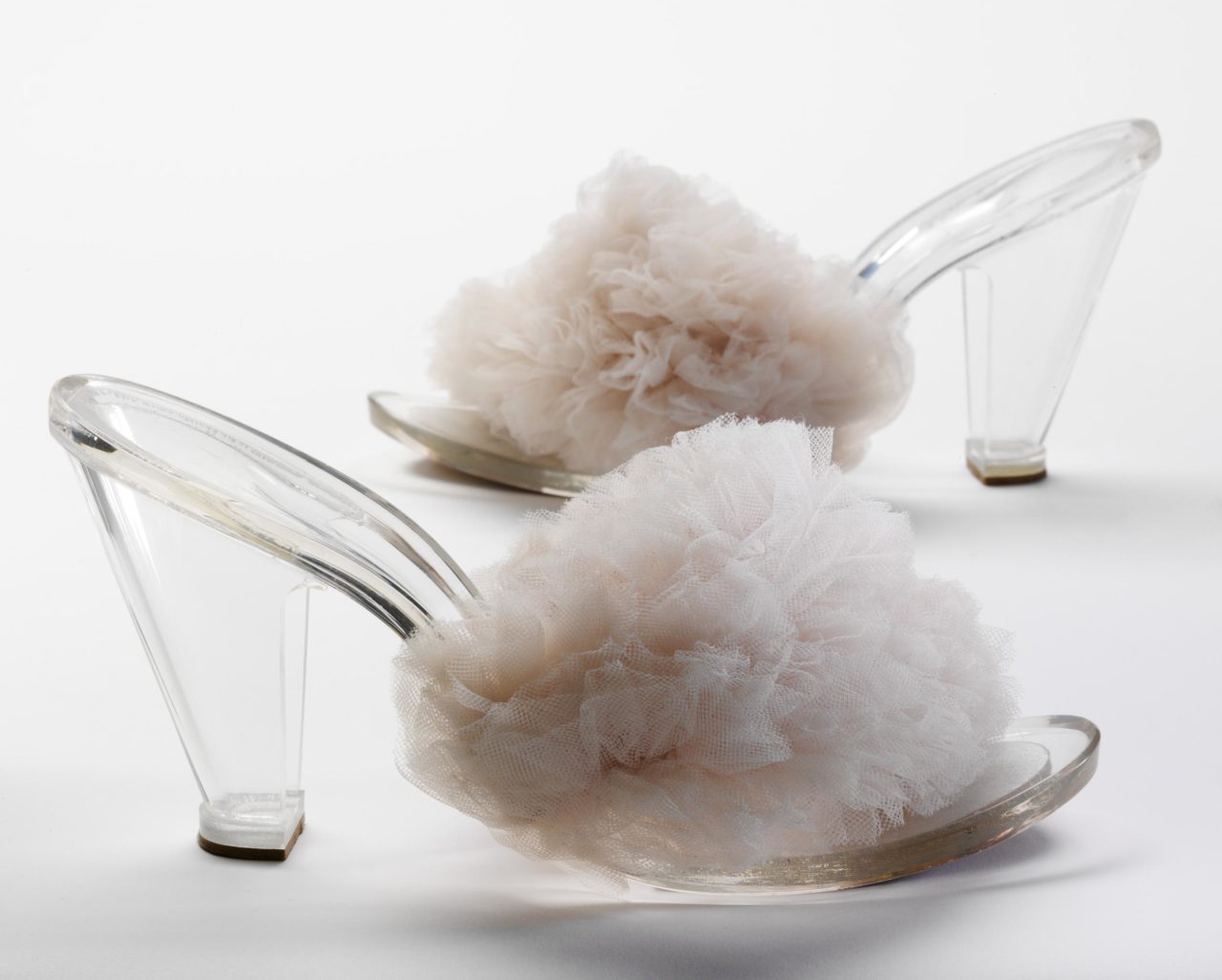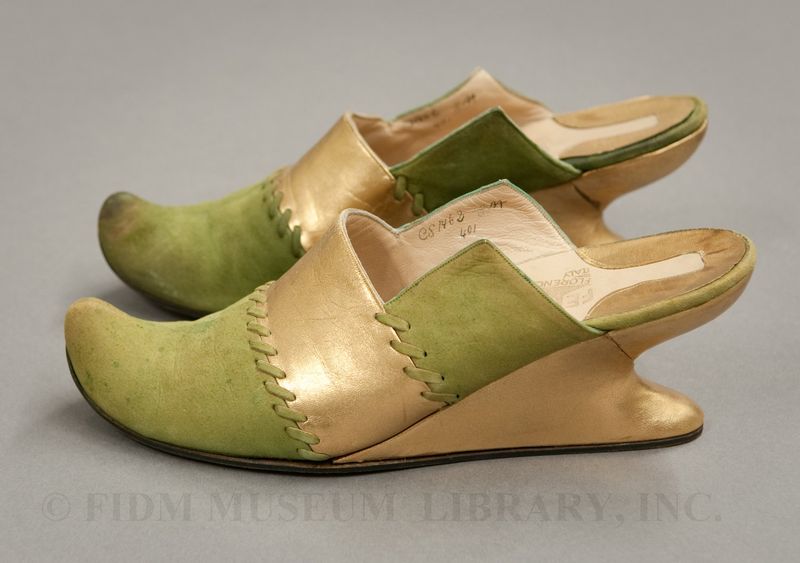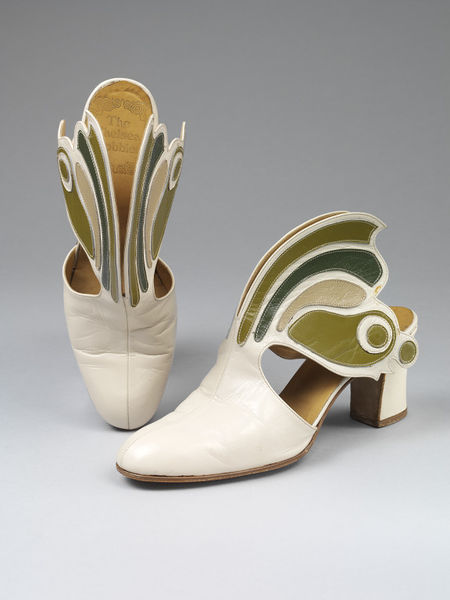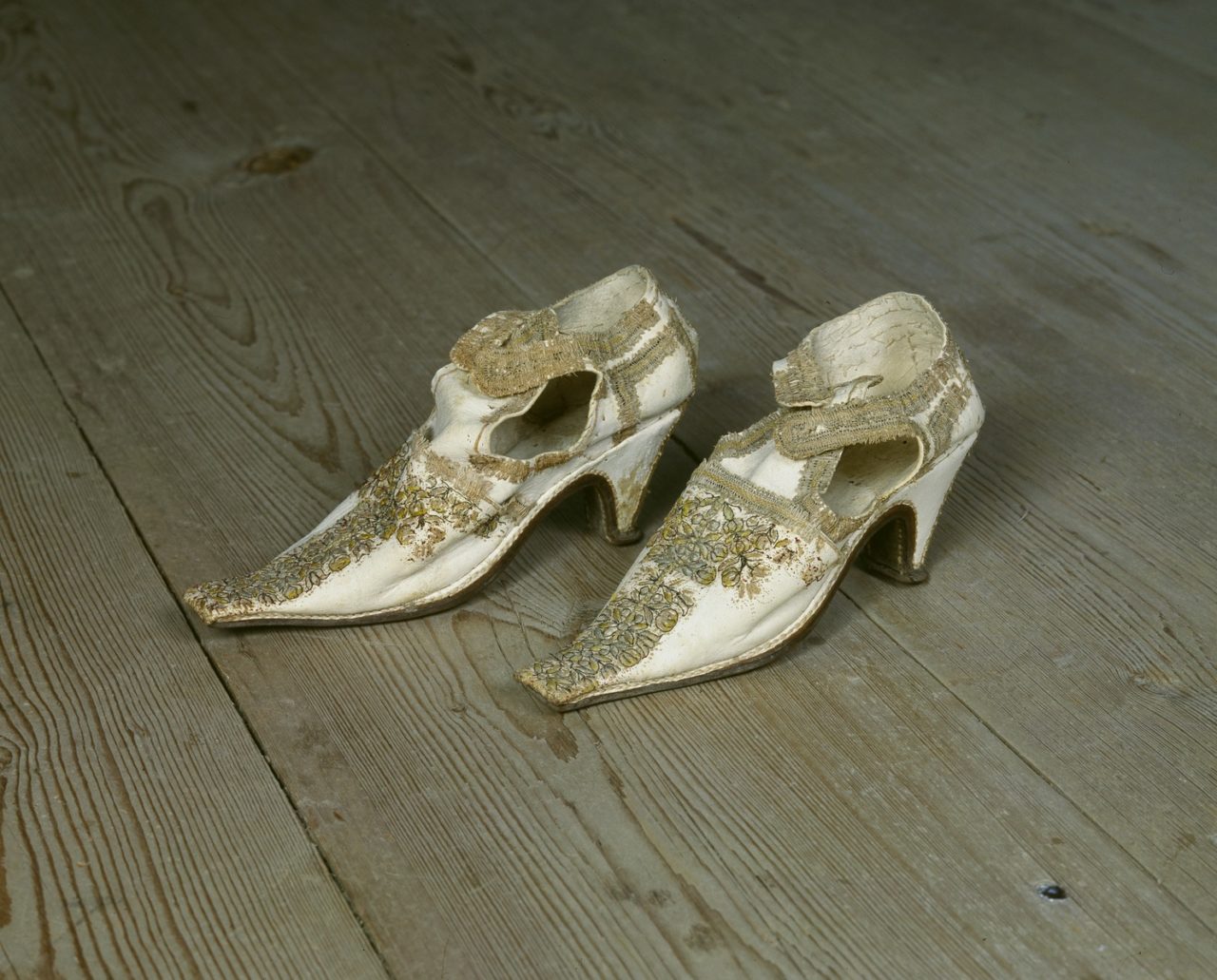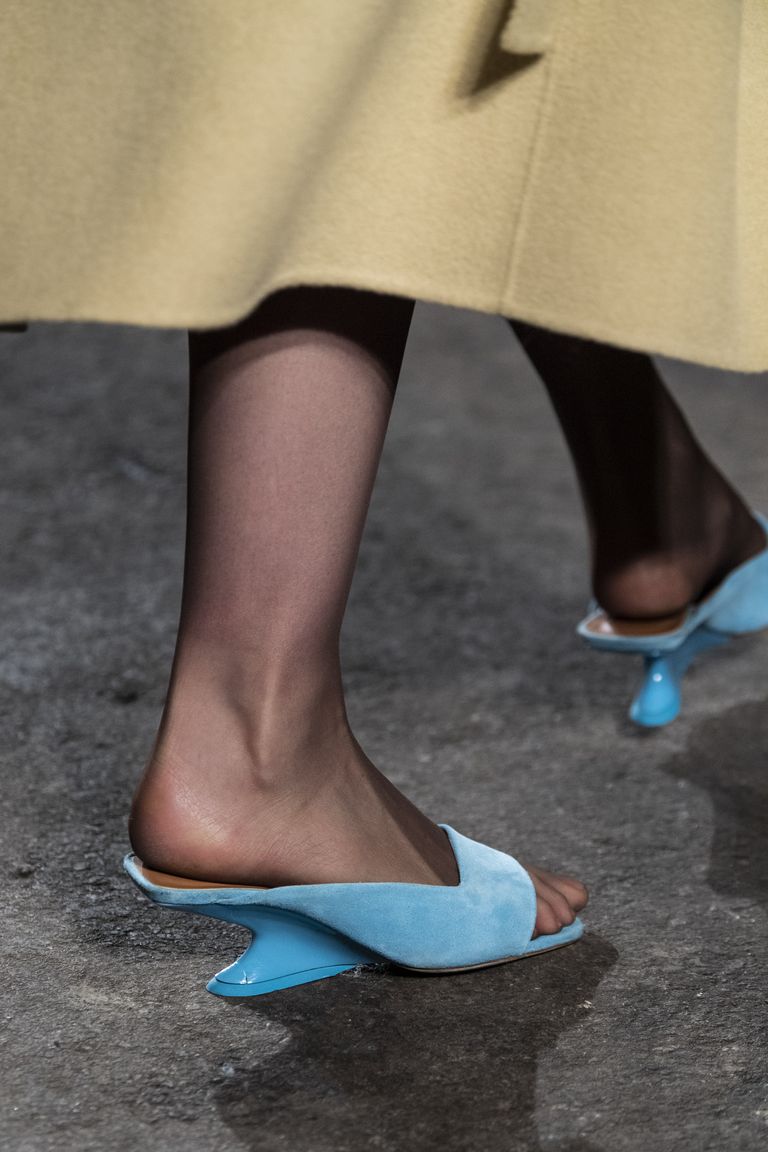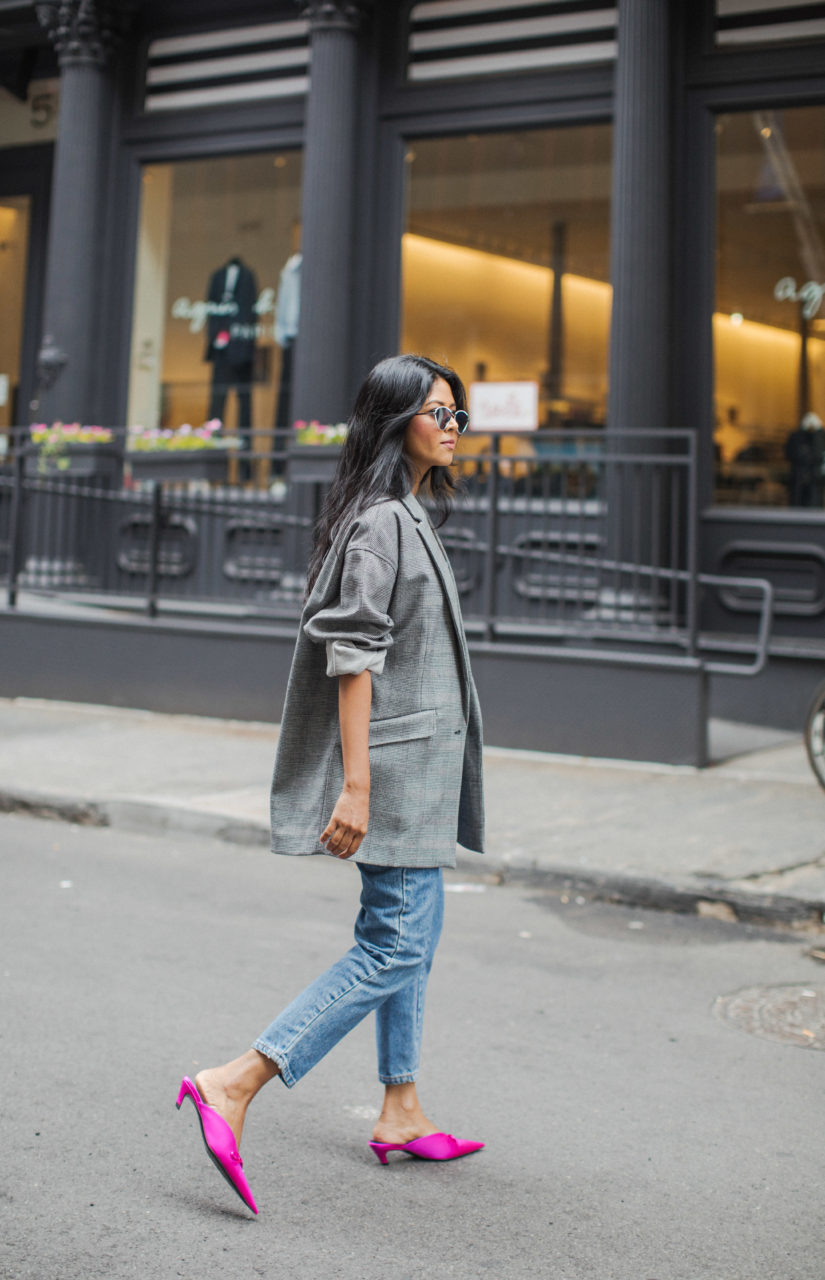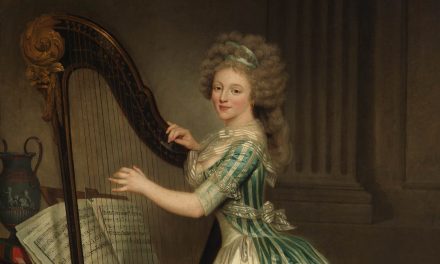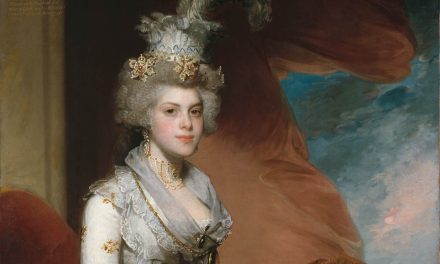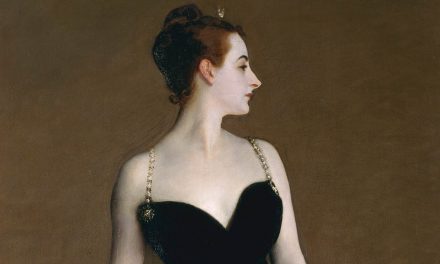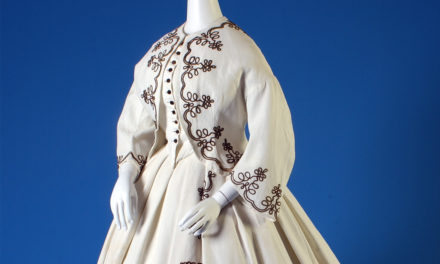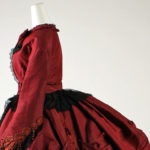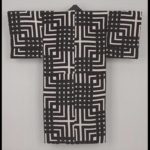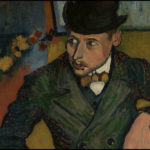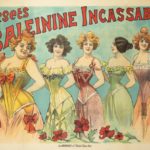A mule is a backless shoe.
The Details
Mary Ellen Snodgrass describes the age and ungendered nature of the mule in her 2015 encyclopedia World Clothing and Fashion:
“From prehistory to the early Middle Ages, the original unisex backless slides (or mules) and sandals of hemp and sisal, hide foot wrappings, wood clogs, and the leather turnshoe made no gender differentiation.” (“Shoes, Women’s”)
A wedge mule from the early part of the 17th century (Fig. 1) looks both luxurious and comfortable, and could have been used by a man or a woman.
Margo DeMello defines the mule in her 2009 book Feet and Footwear: A Cultural Encyclopedia:
“Mules, or slippers made with just a vamp and no quarters, arose in the Middle East and were favored by Egyptians, Greeks, and Romans. The term mule comes from the Latin mulleus calceus, which indicated the red slippers worn by Patricians. Mules, known as pantofles, were adopted by French women by the sixteenth century as bedroom slippers. By the end of the seventeenth century, wealthy French women begin wearing high-heeled, highly adorned mules in public, and even king Louis XIV wore them. In fact, many wealthy men wore mules throughout renaissance Europe, perhaps because they are classic indoor shoes and are generally worn by the leisure classes. But revealing ones naked heels in public was, for many, scandalous, and by the nineteenth century the mule retreated back to the bedroom.” (298)
The mules in figure 2 are an example of the high-heeled styles that women wore in the seventeenth and eighteenth centuries. Heel height varied, but the full front part of the foot was usually covered, and toes were pointed. The mules in figure 3 were likely worn by a man, showing sturdy, blocky heels painted red just as Louis XIV’s were. Silk brocade, satin, and velvet were popular choices at this time, but leather was probably more common for practical reasons.
Jonathan Walford explains how the style of mule evolved along with the name in the In The Berg Companion to Fashion (2010):
“By the eighth century, Coptic steles (gravestones) depict the deceased wearing shoes and mules, sometimes decorated with gilded figures and etched linear designs, often in sacred imagery. The shoe had evolved to include a pointed toe and peaked throat and was often made of red kid. Called mulleus in Latin, referring to the red color, it is from this connection that the modern term ‘mule’— for a backless shoe—originates. This style can still be found in parts of the Middle and Far East.”
While most of the older mules that survive today are elaborately decorated and belonged to elite wearers, mules were worn throughout society. The laundress painted by Greuze in figure 4 is wearing a pair that seem too short for her, which may be made of the popular red kid leather that Walford describes.
Certain kinds of mules are more similar to house slippers, like the one in figure 5. Its delicacy and lack of structure tell us that it was a shoe for wearing around the home; it would quickly have been dirtied or destroyed in a different environment. Mules from this era were often embroidered, and as DeMello pointed out, only worn at home for most of the nineteenth century.
Fashion historian François Boucher writes in 20,000 Years of Fashion: The History of Costume and Personal Adornment (1987) about the rich fabrics and decorations as well as the construction:
“Women’s shoes are often made of silk; the increasingly high heel remains balanced because of its position under the arch of the foot, whether for closed shoes or for mules.” (292)
The pair in figure 6 shows the balanced Louis heel that Boucher discusses, along with a silk vamp. For additional luxe, it is fully beaded, a technique that can also be seen on mules in the previous century. This is probably also a pair of shoes for wearing around the home.
Doreen Yarwood writes in Fashion in the Western World (1992):
“Shoes, often matching the gown in colour, were made from a variety of materials: kid, satin, brocade, silk, velvet. They were embroidered and decorated by jewelled buckles. In style toes were pointed and high heels curved. High-heeled mules and slippers were also worn.” (64)
The 1920s mules in figure 7 are a pink brocaded silk and may have been made to match a lounging set. They are relatively tame for the 1920s, and again, probably at-home shoes.
In The Dictionary of Fashion History (2010), Valerie Cumming, C. W. Cunnington, & P. E. Cunnington give their definition of mules and pantofles:
“Mules, moiles, moyles, mowles (F&M)
Period: 16th century onwards.
A light indoor shoe with only a front section, either flat-soled or high-heeled. ‘A slipper without heel-piece or quarter.'” (137)“Pantofles, pantables, pantacles, pantobles, pantibles (F&M)
Period: Late 15th to mid-17th century.
Over-shoes in the form of mules. Very common from 1570.” (148-49)
DeMello adds to the discussion with mules in popular culture in the 20th century:
“Today, high heeled mules are still considered extremely sexy and are popular among shoe fetishists. Mimi Van Doren and Marilyn Monroe were both photographed in high-heeled mules, and Frederick’s of Hollywood has sold mules since 1961 and popularized marabou-trimmed mules for a generation of American housewives. Candie’s brought mules back into fashion in the United States in the 1970s and they remain sexy today.” (298)
The Perspex 1940s mules in figure 8 are boudoir shoes, and imitate the classic marabou-feather heels in form while experimenting with new materials. Contemporary and yet starkly different, the 1944-45 Ferragamo heels in figure 9 demonstrate a new form entirely, with geometric, extended sides, light green suede, and a sinuous cutout heel. Jumping ahead to the 1970s, when DeMello claims they truly came into American fashion at large, the mules in figure 10 incorporate butterfly-like extensions to frame the ankle, but otherwise greatly resemble the design of seventeenth-century court shoes (Fig. 11).
Fig. 1 - Designer unknown (British). Mules, First quarter 17th century. Linen, silk, metallic, leather. New York: The Metropolitan Museum of Art, 29.23.11. Rogers Fund, by exchange, 1929. Source: MMA
Fig. 2 - Designer unknown (European). Pair of women's mules, Late 17th–early 18th century. Leather, silk velvet, silk satin ruching with silvered metal toe, leather lining and leather heel and sole. Boston: Museum of Fine Arts, 43.1716a-b. The Elizabeth Day McCormick Collection. Source: MFA
Fig. 3 - Designer unknown (Possibly Italian). Pair of mules, ca. 1700. Leather, wood, silk, silver, silver-gilt; hand-woven silk brocade, hand-stitched. London: Victoria & Albert Museum, T.213-1916. Given by Mrs Willoughby Hodgson. Source: VAM
Fig. 4 - Jean-Baptiste Greuze (French, 1725-1805). The Laundress (La Blanchisseuse), 1761. Oil on canvas; 40.6 × 33 cm (16 × 13 in). Los Angeles: The J. Paul Getty Museum, 83.PA.387. Source: The Getty
Fig. 5 - Designer unknown. Eggplant satin mule with a band of floral embroidery across vamp and green silk binding tape, 1820-30. Silk, leather. Moscow: Shoe Icons, 1983. Source: Shoe Icons
Fig. 6 - Designer unknown (French). Pair of women's mules, 1890-1900. Glass beads, silk thread, metal braid, silk, and leather; sablé; 6 x 6.8 x 22.9 cm (2 3/8 x 2 11/16 x 9 in). Boston: Museum of Fine Arts, 43.2258a-b. The Elizabeth Day McCormick Collection. Source: MFA
Fig. 7 - Designer unknown (French). Pair of mules, 1920s. Silk, metal thread brocade, leather; 6.3 x 7.3 x 23.8 cm (2 1/2 x 2 7/8 x 9 3/8 in). Boston: Museum of Fine Arts, 1988.413a-b. Gift of Jane P. Guild. Source: MFA
Fig. 8 - Designer unknown (Possibly American). Mules, 1940s. Perspex, nylon net, cotton; 10 x 10 x 22.5 cm. London: Victoria & Albert Museum, T.76:1,2-2014. Source: VAM
Fig. 9 - Salvatore Ferragamo (Italian, 1898-1960). Mules, 1944-45. Los Angeles: Fashion Institute of Design & Merchandising Museum and Galleries, 2004.5.38AB. Museum purchase. Source: FIDM
Fig. 10 - Chelsea Cobbler (British, 1967-present). Pair of shoes, 1971. Leather; 7.5 cm heel, 16 cm top of wing to sole, 23.5 cm long, 7.5 cm wide. London: Victoria and Albert Museum, T.106&A-1974. Given by Mr Paul Getty, Jr.. Source: VAM
Fig. 11 - Designer unknown (Swedish). Damsko, Seventeenth century. Leather, metal embroidered silk; height: 14, length: 17 cm. Håbo Municipality: Skokloster Castle, SKO 11966. Source: emuseum
Its Afterlife
Fig. 12 - Walter Chiapponi for Tod's (Italian). Mules, A/W 2020. Milan Fashion Week, IMAXTREE. Source: Elle
Fig. 13 - Rejina Pyo (South Korean, 1983-present). Mules, A/W 2020. London Fashion Week, IMAXTREE. Source: Elle
Fig. 14 - Demna Gvasalia for Balenciaga (Italian, 1981-present). Balenciaga knife mules, 2017-18. Silk satin. Source: Walk in Wonderland
References:
- Boucher, François. 20,000 Years of Fashion: The History of Costume and Personal Adornment. New York: H. N. Abrams, 1967. http://www.worldcat.org/oclc/757693829
- Cumming, Valerie, Cecil Willet Cunnington, and Phillis Cunnington. The Dictionary of Fashion History. Oxford: Berg, 2010. http://www.worldcat.org/oclc/886233425
- DeMello, Margaret. Feet and Footwear: A Cultural Encyclopedia. Santa Barbara, Calif: Greenwood Press/ABC-CLIO, 2009. http://www.worldcat.org/oclc/759829778
- Feiam, Ally. “10 TOP TRENDING SHOES FOR WOMEN IN 2020.” Trendspotter. Accessed 25 March 2020. https://www.thetrendspotter.net/trending-shoes-for-women/
- Snodgrass, Mary Ellen. World Clothing and Fashion: An Encyclopedia of History, Culture, and Social Influence. New York: Routledge, 2015. http://www.worldcat.org/oclc/908851801
- Steele, Valerie, ed. Encyclopedia of Clothing and Fashion. Scribner Library of Daily Life. Detroit: Thomson/Gale, 2005. http://www.worldcat.org/oclc/1057965219
- Walford, Jonathan. “Shoes, Women’s.” In The Berg Companion to Fashion, ed. Valerie Steele. Oxford: Bloomsbury Academic, 2010. Accessed December 18, 2018. https://www.bloomsburyfashioncentral.com/products/berg-fashion-library/encyclopedia/the-berg-companion-to-fashion/shoes-womens
- Yarwood, Doreen. Fashion in the Western World, 1500-1990. New York: Drama Book, 1992. http://www.worldcat.org/oclc/26407719




